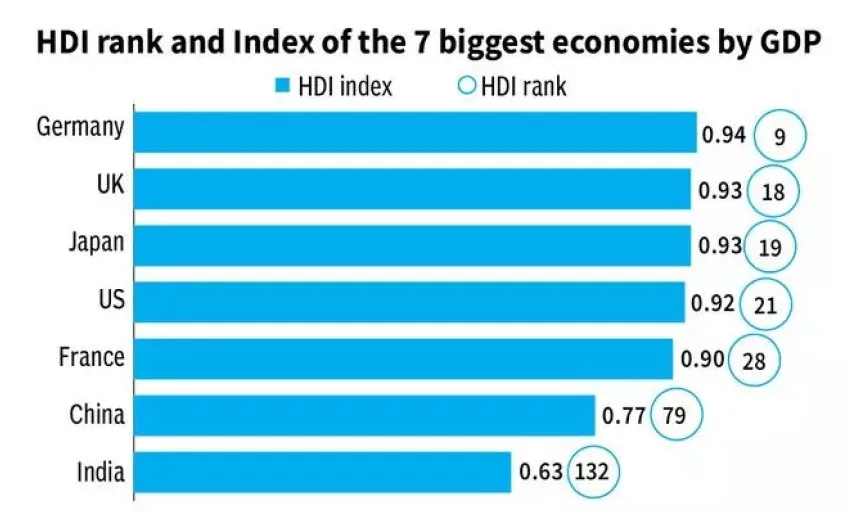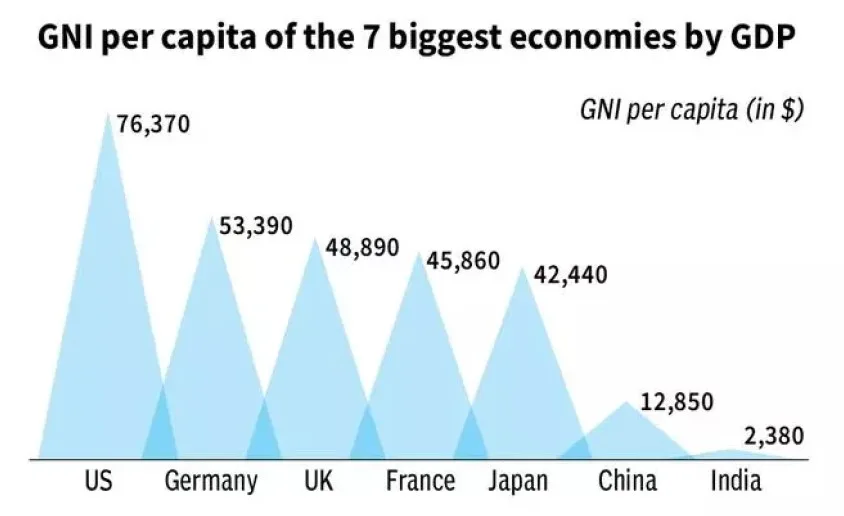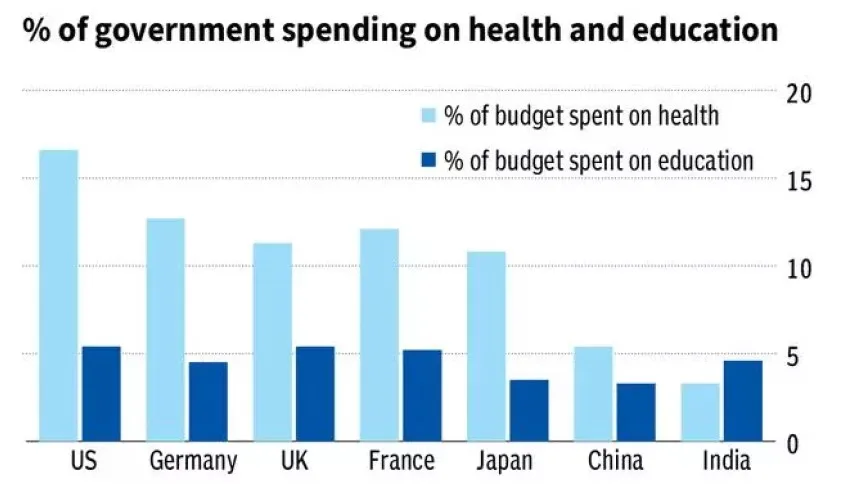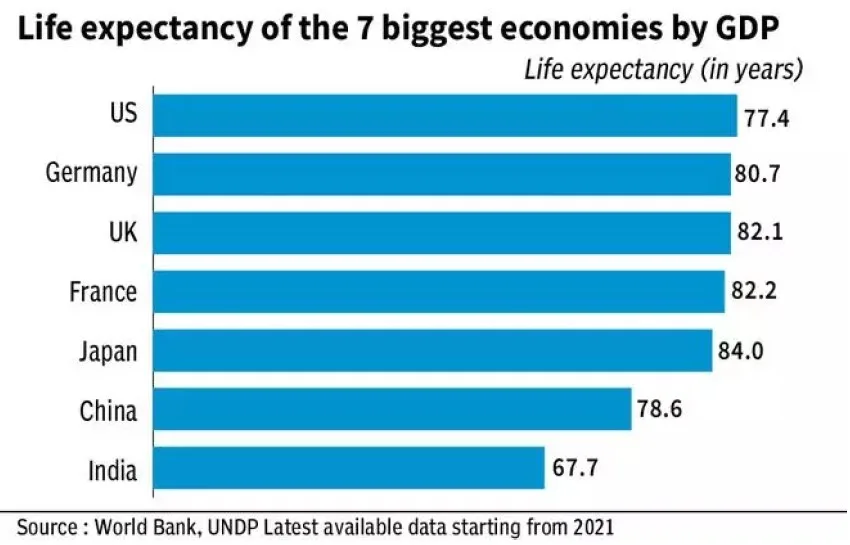Syllabus: GS3/Economic Development
Context
- India’s recent announcement of its goal to become a developed country by 2047 has sparked a renewed debate on what defines a developed nation and the key parameters necessary to achieve this status.
About the Developed Country
- The term ‘Developed Country’ (aka Advanced Country) doesn’t have a single accepted definition. It stands out for its high quality of life, robust economy, and advanced technological infrastructure. These nations have typically surpassed the initial stages of industrialization and agrarian economies.
- The United Nations Development Programme (UNDP) has a threshold of the 75th percentile in Human Development Index (HDI) distribution to be classified as a developed country, whereas the World Bank classifies countries whose Gross National Income (GNI) per capita is above $13,845 as ‘high-income countries’.
Key Features
- Economic Prosperity: Developed countries boast impressive economic metrics. These often include a high Gross Domestic Product (GDP) and Gross National Product (GNP) per capita. Essentially, their citizens enjoy a relatively comfortable standard of living.
- Industrialization and Infrastructure: Developed nations have well-established infrastructure—think efficient transportation networks, modern airports, and reliable electricity grids. Their cities showcase towering skyscrapers, bustling commercial centres, and well-maintained roads.
- Quality of Life: Access to quality education, healthcare, and public services is widespread. Citizens benefit from robust social safety nets, ensuring a decent quality of life for all.
- Environmental Stewardship: Developed countries prioritise environmental protection. You’ll find recycling programs, clean energy initiatives, and strict adherence to civic norms.
- Technological Advancements: Cutting-edge technology permeates daily life. From seamless digital services to advanced research institutions, these nations lead the way.
Key Comparison of India With Other Countries




How Can India Bridge the Gap?
- India, with its rich history and diverse culture, has set ambitious goals, and declared that India should achieve developed country status by 2047—marking the 100th year of our independence.
- Economic Growth: India’s GDP growth is crucial. According to projections, India could become the world’s third-largest economy by 2030 and even surpass the US in GDP by 2060.
- However, sustaining an annual growth rate of at least 8% is essential.
- Investment in Infrastructure: India must continue investing in infrastructure—modernising roads, railways, and digital networks. Connectivity is key to progress.
- Education and Healthcare: Ensuring quality education and accessible healthcare for all citizens is non-negotiable. A well-educated workforce drives innovation and productivity.
- Environmental Responsibility: Balancing growth with environmental conservation is critical. India can lead by adopting sustainable practices and clean energy solutions.
- Inclusive Development: Addressing income inequality and poverty eradication is paramount. No one should be left behind on the path to development.
Opportunities For India
- Demographic Dividend: India’s young population can be an asset. Properly harnessing their potential through education, skill development, and employment can drive growth.
- Robust Information Technology Sector: India’s IT industry has been a global success story. Continued investment in technology and innovation can propel the nation forward.
- Entrepreneurship Ecosystem: India has seen a surge in startups and entrepreneurial ventures. Nurturing this ecosystem can create jobs and foster innovation.
- Strategic Investments: Focused investments in human capital (education, healthcare) and infrastructure (roads, ports, digital connectivity) are crucial.
- Global Partnerships: Collaborating with other nations, sharing knowledge, and participating in global value chains can accelerate development.
Challenges India Faces in Achieving Developed Status and Related Solutions
- Population Management: Our sheer population can strain resources. Sustainable population management strategies are essential to ensure equitable growth.
- Inequality and Social Justice: Income disparities persist. Addressing this gap requires targeted policies that uplift marginalised communities, promote social justice, and provide equal opportunities.
- Gender equality, LGBTQ+ rights, and inclusivity in all spheres of life contribute to a more developed and harmonious society.
- Bridging the gap between urban and rural areas is crucial.
- Socioeconomic Inclusion of Rural India: By 2030, an estimated 40% of Indians will be urban residents. However, rural areas still grapple with inadequate infrastructure, limited access to quality education, and healthcare disparities. Achieving balanced development across urban and rural regions is vital.
- Empowering rural communities through education, skill-building, and better livelihood opportunities is a pressing challenge.
- Bureaucracy and Corruption: Streamlining administrative processes, reducing red tape, and promoting transparency are perennial challenges. Efficient governance is crucial for sustained progress.
- Education Reform: Quality education is the cornerstone of development. India needs reforms that enhance both access and quality. Vocational training and digital literacy are equally important.
- Health and Sustainability: A healthy population is the bedrock of any developed nation. India faces health challenges ranging from malnutrition to non-communicable diseases. Improving healthcare infrastructure, preventive measures, and access to quality medical services is imperative.
- Moreover, sustainability—both environmental and economic—is critical. Balancing growth with ecological responsibility is a tightrope walk. India must lead in adopting clean energy solutions, efficient waste management, and climate-conscious policies.
- Skill Development and Employment: As the world evolves, so do the skills required for success. According to the World Economic Forum, more than half of Indian workers will need reskilling to meet the demands of the future job market. Bridging this skills gap is crucial for sustained economic growth.
- Additionally, ensuring meaningful employment opportunities for our burgeoning workforce—especially in the context of automation and digital transformation—is essential.
- Infrastructure and Connectivity: While India has made significant strides in infrastructure development, there’s still work to be done. Modernising transportation networks, ensuring reliable electricity supply, and bridging the digital divide are ongoing tasks.
- Connectivity—both physical and digital—fuels economic progress. Investments in roads, railways, and high-speed internet are essential.
Conclusion
- India’s journey toward becoming a developed country is multifaceted. It lags behind in HDI rank mainly because of its low life expectancy and per capita income, which can be improved with government spending in the education and health sectors.
- It requires a delicate balance of economic growth, social inclusion, environmental stewardship, and visionary leadership. With determination, strategic planning, and collective effort, we can transform our nation into a beacon of progress.
| Daily Mains Practice Question [Q] India has set an ambitious goal of becoming a developed nation by 2047. In this context, discuss the key parameters that define a developed country and critically analyze the challenges India needs to overcome to achieve this goal. |
Previous article
India’s Critical Mineral Mission and Africa’s Role
Next article
Innovating e-commerce in India